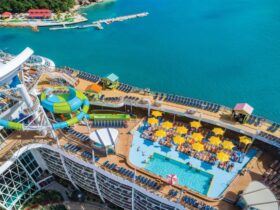With the increasing popularity of adventure travel in Singapore, Weekender speaks to diving experts to bring you the most enticing scuba spots and useful tips for divers of all levels
By Pamela Chow

The Earth comprises more than 70 per cent ocean — that’s more than 70 per cent of the world waiting to be explored outside of land travel.
While mankind may not be able to uncover many of the mysteries of the ocean and its depths, those with diving licenses are able to dive under and journey into the spectacular ecosystems at the ocean floor.
If you’re one such lucky diver, you may be wondering where to head to for your next underwater exploration, and could do with some extra tips and recommendations. Three professionals from diving clubs in Singapore share their expert tips and recommendations for divers of different experience levels looking for the next exciting expedition.
Useful tips for new divers

Sipadan Island’s waters are famous for wall diving but, due to the waters being protected, only 120 divers are allowed to dive here daily. (Photo: Soren Egeberg Photography / Shutterstock.com)
So, you’ve officially completed your scuba diving training and can’t wait to embark on an aqua adventure. But, before you get your tank and fins out, how can you be absolutely certain that you’re not diving headlong into dangerous territory?
Eugene Kwok, diving instructor at Amazing Dive, cautions that divers should not plan for a scuba trip the way you’d plan a regular getaway. He says that some divers, even experienced ones, make the mistake of favouring cheaper dive guides when comparing prices.
Kwok advises, “It doesn’t mean that the cheaper ones are bad. You have to go down to the shop and assess: Are they taking care of the store and equipment? Do they give you the right vibes? Do you trust your life with them?”
To play it safe, renowned diving destinations such as Tioman, Redang and the Perhentian Islands in Malaysia would have plenty of information available on reputable and reliable dive shops, due to their popularity. These islands are ideal for divers hoping to make a regular or long-weekend trip, Kwok explains, and are easy to arrange transport to.
However, beginners who are looking for a little more adventure can head out to the lesser-known Tenggol Island, slightly further out in the East of Malaysia and about ten hours by bus. According to Kwok, the waters of Tenggol are safe but more exciting, as the reefs of beautiful corals are relatively untouched.
Turtles, schools of barracuda and even whale sharks have been spotted by divers here, says Kwok. Tenggol also has a good mix of macro marine life — known as “critters” — which more experienced divers often look out for.
Limited protected sites and deep discoveries

Tenggol Island is a recommended spot for divers who are just starting out, as its waters are safe and clear, yet largely untouched and full of surprises.
If you’ve got more experience under your belt and are chasing an even more exhilarating dive, Sipadan Island in Sabah, Malaysia is a unique location that divers in the region often rave about.
Diving in Sipadan’s reefs is a privilege in itself. Due to the waters being protected, only 120 divers are allowed to dive here each day. Places are determined by balloting.
It’s here that you can experience wall diving, where more experience and confidence is critical. This is where a reef drops into the deep sea, creating a wall that accumulates marine life and its food. Everything is larger here, from turtles to schools of bump-head parrotfish.
Those embarking on wall diving, however, must have an advanced license allowing dives of up to 40m, explains Kwok. He said, “It’s easy to spiral out with no reference at the bottom [of the ocean]. We need to be comfortable and develop an awareness of depth.”
In fact, Wu Yi, General Manager of Dive Your Choice, recommends all beginner divers to obtain a PADI (Professional Association of Diving Instructors) Advanced — or equivalent — certification.
More experienced divers may also be on the prowl for more interesting sights beyond clear reefs; the famous muck diving spots in Lembeh or Ambon in Indonesia are some of Kwok’s recommendations. The sand here is black thanks to surrounding volcanic activity, and is home to small and unique critters not seen anywhere else.
However, Kwok advises, for muck diving, divers need a “deep appreciation of marine life”.They must also be very good with buoyancy so as not to stir up the muck while getting close to the critters, and must be better with air consumption as muck dives tend to stretch for a longer duration.
Diving in the middle of nowhere?

In muck diving, divers must be very good with buoyancy so as not to stir up the muck while getting close to the critters. (Photo: Anthony Patterson)
Are you confident in navigating more challenging underwater conditions, inclu-ding stronger currents, higher pressures, lower visibility and lower temperatures?
For divers who have clocked in a higher number of dives, Wee and Rafi Masjid, of The Dive Company, recommend exploring places such as Indonesia’s Raja Ampat, Komodo and Pulau Weh, Malapascua in the Philippines, the Similan Islands in Thailand, and the Maldives.
Also read: Why live-aboard diving is the best way to experience the Similan Islands
Wu shares, “These places are good for pelagic diving, where the currents might get pretty strong at some dive sites.” Pelagic diving — often known as “diving in the middle of nowhere” or “black water diving” — is where divers explore waters neither close to the bottom nor near the shore.
What does Wu find the most challenging condition? She says that, while it differs from individual to individual, she personally finds the cold temperatures of the depths the most challenging.
For divers who are more similar to Kwok, who finds strong currents and low visibility the most challenging conditions, he recommends another set of diving spots for wholly different experiences.
The Galapagos Islands in South Africa is a grand destination to catch the sardine run. Kwok says, “You need to do a lot of waiting for the guide to spot the sardine ball but you’ll dive in for that moment when you see everything happen before you.”
The waters are colder here, requiring a different set of equipment to keep divers warm.
So, the top tips from the professionals are: Do your research on more reputable diving guides at your destination; do even more research on the water conditions and dive in with a sure footing of what you are and are not confident of.
Most importantly, don’t forget to take in all the majesty of the ocean before you.
Scenic spots for snorkellers & learner divers
Do you wish to explore the beauty of the ocean but haven’t gotten a diving license? These experts share their advice.
Wee, Dive Your Choice
“Tenggol, in Malaysia, is a pretty good place for non-divers. Quiet, peaceful and not commercialised.”
Rafi, The Dive Company
“Most places offer dive sites [for all levels], and usually the dive centre will decide the level of equipment for each individual.”
Weekender would like to thank Amazing Dive, Dive Your Choice and The Dive Company for their cooperation in this feature.
ADVERTISEMENTS










3 Comments